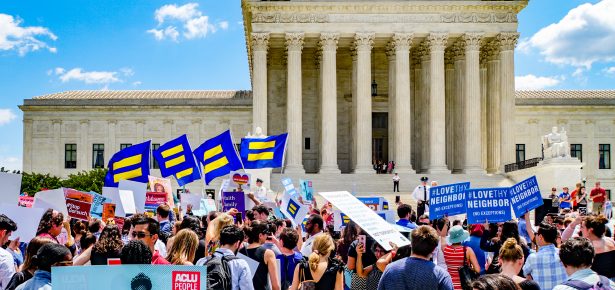
The Republicans’ rush to appoint Judge Amy Coney Barrett before the presidential election is yet another example of polarized politicians and citizens fighting over an increasingly polarized Supreme Court. Even before Justice Ginsburg’s death, the Court had all the makings of unprecedented polarization: lots of conservative rulings with fractious (5-4) opinions. American conservatives have reveled in the prospects of a conservative judicial revolution, while liberals fear that years of hard-won victories are at risk.
Yet the 2019-2020 term left conservatives disappointed and liberals relieved as the Supreme Court steered a middle course, delivering “wins” for liberals and conservatives with relative parity. The star of this episode is Chief Justice Roberts, who was in the Court’s majority in all but two cases and officially became the swing justice (a status that could now be short-lived with the addition of a new conservative justice). How can we understand this turn of events?
One popular answer is that Chief Justice Roberts is undergoing “leftward drift” like some past Republican appointees. To many, Roberts’ purported drift is indeed surprising given his conservative credentials both on and off the high court.
We do not think ideological drift provides a satisfactory answer, nor is the case closed that Roberts is actually “moderating away” from his conservative posture. In fact, political science research tells us that the Court’s moderate tenor is neither surprising nor is it out of step with other periods in contemporary Court history.
Because the Court lacks formal enforcement mechanisms to implement its decisions, it is reliant on the goodwill of the political branches and the public for its power. Conventional wisdom says that because citizens hold the Court in high esteem, they are willing to punish elected officials at the ballot box for politically-motivated attacks on the Court. Representatives will thus resist such “Court-curbing” attempts and instead defer to the Court’s rulings. As a result, the Court is free to rule according to its true preferences (it is independent) and its decisions are faithfully implemented (it is efficacious).
Yet a growing body of work suggests this story needs revision, that citizens are quite willing to countenance attacks on the Court in the face of policy or ideological disagreement with the Court and its rulings. Such a posture is exacerbated by partisan polarization. The “reservoir of goodwill” posited by previous research is shallow and evaporating.
Justices thus face a dilemma: They need to balance their sincere policy preferences with their beliefs about what the public and elites are willing to tolerate. If the Court unleashes a series of unpopular or consistently ideological rulings, the risk of backlash is substantial. While they may win the battle (ruling sincerely), they run the risk of losing the war (noncompliance, having their powers reduced). In short, the prospect of Court-curbing attacks induces strategic behavior — the Court deviates from its sincerely preferred course of action in order to maintain credibility and authority in the political system. Whereas classic perspectives view the public as a “guardian of judicial independence,” this view paints the public as a constraint on judicial independence.
If manifested in an unconstrained fashion in our hyper-partisan era, the Court’s polarized configuration provides a perfect storm for Court-curbing attacks. This prospect is exemplified by calls for Court-curbing among liberals and Democrats in the aftermath of the Republican Senate’s alleged “stealing” of two Supreme Court seats — the Scalia vacancy in 2016-2017 and now the Ginsburg vacancy — and its position reversal on advancing appointments in an election year. The Court’s moderation in its recent decisions is a strategic response to preempt Court-curbing threats.
As Chief Justice of the United States, Roberts is particularly concerned about maintaining the Court’s legitimacy and keeping it out of partisan political crosshairs. Thus, the Roberts-led Court steers a middle course, handing down rulings that satisfy liberal interests one day and conservative interests the next. Because Court-curbing is motivated by policy disagreement, neither side can mount a sustained attack on the Court’s independence for long. Again, the public acts as a constraint on judicial independence.
Why is Chief Justice Roberts suddenly getting attention for his actions despite serving on the Court since 2005? Until 2018, Justice Anthony Kennedy served this role as “strategic moderator,” acting as swing voter in most salient cases. Kennedy’s presence attenuated the need for Roberts to be strategic. And when Kennedy voted to invalidate the Affordable Care Act (ACA) in 2012, Roberts switched his vote to uphold, arguably a strategic calculation to avoid backlash for striking down an incumbent president’s signature domestic achievement during an election year. With Kennedy’s departure, and the country and Court more divided than ever, the Chief Justice has increasingly taken on an “institutional maintenance” role of ensuring the Court’s credibility and influence.
The incentives faced by both politicians and judges are shaped to a large extent by the public’s willingness to forego narrow political benefits to protect the efficacy and integrity of the Court in the political system. We suggest that citizens show little loyalty in this regard, especially in sharply divided times when every political battle appears existential. In turn, the Supreme Court’s independence and power is much reduced relative to a world in which citizens were more principled defenders of the judiciary.
Latest Comments
Have your say!